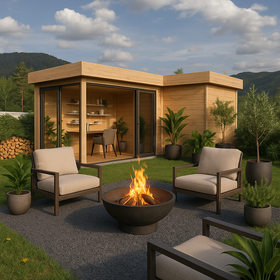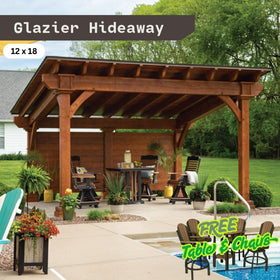512-777-0154

What's the Difference Between Pergola and Gazebo?
You’ve probably seen both. A pergola here. A gazebo there. Maybe in a neighbor’s yard or during a Pinterest scroll that spiraled out of control.
They look similar at a glance. And let’s be honest—most people treat the names like they’re the same thing.
They’re not.
The difference matters, especially if you’re thinking about adding one to your outdoor space. Whether you’re planning a full backyard makeover or just figuring out where your grill should live, knowing which structure does what can save you time, money, and a few head scratches.
So what actually sets a pergola apart from a gazebo?
1. Pergola vs. Gazebo: Let’s Start With the Basics
Let’s clear something up.
A pergola and a gazebo are not the same thing. But the confusion makes sense—they both live in backyards or an outdoor kitchen, offer shade, and make your outdoor space feel more put together.
Still, the way they’re built (and what they’re built for) is different.
A pergola like Brookside Timber Frame Highland Oasis Pergola is a structure with vertical posts and an open roof. The roof isn’t solid—it’s usually slatted or cross-beamed. That means it offers partial shade, not full cover. Some pergolas attach to the side of a house. Others stand on their own, somewhere in the yard. Either way, they’re more of an open-air frame than a full shelter.

A gazebo is fully enclosed on top. It has a solid roof, usually pitched. The shape is often round or octagonal, but not always. It’s always freestanding. Some have railings or built-in benches. Think of it as an outdoor living room with garden furniture —more private and weather-friendly.
Here’s a quick side-by-side:
|
Feature
|
Pergola
|
Gazebo
|
|---|---|---|
|
Roof
|
Open/slatted
|
Fully covered
|
|
Structure
|
Attached or freestanding
|
Always freestanding
|
|
Shade
|
Partial
|
Full
|
|
Style
|
Modern, minimal
|
Classic, enclosed
|
|
Common Use
|
Patio cover, garden feature
|
Shelter, seating area
|
In short: pergolas define a space. Gazebos protect a space.
If you want structure without feeling boxed in, a pergola might fit the bill. If you need full shade or shelter from rain, a gazebo’s more your style.
2. Let’s Talk Style: How Each One Shapes Your Space
Style might not be the only factor when choosing between a pergola and a gazebo, but let’s be honest—it plays a big role.
These aren’t just functional structures. They shape the vibe of your backyard. How it looks. How it feels. And how people use it.
Pergolas Bring a Modern, Minimal Vibe
If your style leans clean and simple, a Brookside Timber Frame Zion Resort Pergola fits right in.
It’s all about straight lines, open air, and understated structure. The kind of design that doesn’t try too hard, but still makes a statement.
Pergolas work well over patios, walkways, or as a frame for an outdoor dining setup. They give just enough definition to a space without closing it in.
Most are made from wood, vinyl, or powder-coated aluminum. Some are painted. Others left natural. You’ll often see them with string lights, hanging plants, or a retractable canopy to dial in the shade.
It’s part shade, part structure, part style.
Gazebos Are All About Structure and Charm
Gazebos lean more traditional. Think of them as the centerpiece of a backyard, not just an accent.

The solid roof creates a cozy, enclosed feel. It’s not a full room—but it comes close. Some even include railings, benches, or screens to keep bugs out.
Gazebos are popular in gardens, parks, and big open lawns. They often show up at weddings or events for good reason—they look intentional and polished.
Materials vary, but wood and metal are most common. Some have shingles. Others use metal roofing or even thatched tops.
They offer structure with a little flair. More charm than minimalism.
3. How Much Shade (and Shelter) Do You Really Want?
Style matters. But comfort? That’s non-negotiable.
If you're spending time outside, you’ll need to think about how much sun—or rain—you’re willing to deal with.
Pergolas like Brookside Timber Frame Shadelan Retreat Pergola, offer partial shade. That’s their thing. The open roof lets some sunlight through, which is great if you like a bit of warmth without baking. Add climbing vines, fabric panels, or a retractable canopy, and you’ll get more control. But even with upgrades, pergolas don’t block everything. If it rains, you’ll still feel it.
Gazebos give full coverage. The solid roof keeps out sun, rain, and even light wind. It’s the better pick if you want to stay dry or sit outside when the weather turns. It also means less worrying about your outdoor furniture getting soaked.
So ask yourself a few quick questions.
Are you mainly looking for shade during sunny afternoons? Or do you want a sheltered spot you can count on even when it drizzles?
Do you like that open-air feel, or are you after something more enclosed?
There’s no right or wrong—just what works best for how you use your space.
4. Installation, Upkeep, and Cost—What to Expect
Now that you’ve got the basics down, let’s talk about what it actually takes to get one of these in your backyard.
Because design is fun. But time, tools, and budget? That’s where the real decisions happen.
Pergolas Are Usually Simpler to Build
Most pergolas like Brookside Timber Frame Timber Resort Pergola are built from just a few key parts—vertical posts, beams, and an open-style roof.
That simplicity makes them easier to install. Some people even go the DIY route, especially with pre-cut kits. If you’re handy (or know someone who is), it’s a doable weekend project.
They also don’t need a foundation, which cuts down on prep work and cost. You can build one directly over a patio, deck, or even gravel.
As for price? It depends on size and material. A small vinyl pergola might cost a few hundred dollars. A large custom wood one? A few thousand.
But overall, pergolas tend to be the more budget-friendly option.
Gazebos Require More Work—and Money

Gazebos are more involved. You’re dealing with a solid roof, detailed framing, and sometimes built-in features like railings or seating.
That means more time, more materials, and usually a need for professional help. Some even require permits, depending on where you live.
You’ll also need a solid base—usually a concrete pad or a raised platform—to support the weight. That adds to both the cost and the prep time.
Because of all this, gazebos typically cost more. And maintenance is a bit heavier too. Roofs might need repairs. Wood frames could require sealing or painting.
It’s not unmanageable. But it’s worth knowing before you dive in.
5. Use Cases: What Do You Want This Structure to Do?
Form matters. But function? That’s where things get interesting.
A pergola and a gazebo aren’t just different in looks—they serve different purposes, too. What you want your space to do plays a big part in deciding which one fits.
So let’s look at how each structure works in the real world.
Pergolas Make Great Patio Extensions and Garden Features
Pergolas are all about framing a space.
They don’t close things off—they define areas without blocking out light or air. That makes them great over patios, decks, or tucked into garden corners as a casual seating zone.
People often use them to build out an outdoor living area or outdoor dining area. Add an outdoor table, some outdoor seating, and maybe a few string lights, and it feels like a finished room. Just without the walls.
They’re also ideal for supporting climbing plants like wisteria or jasmine. Or for hanging lights, planters, or outdoor curtains if you want a little extra privacy.
Flexible, lightweight, and easy to dress up.
Gazebos Are Made for Gathering and Escaping the Weather

Gazebos are less about blending in and more about standing out.
They’re often the focal point of a yard. A solid, structured place to gather—rain or shine. Because they’re enclosed on top, they offer full shelter. That makes them a safe bet for outdoor furniture or electronics.
They work especially well for larger properties. And they shine during events—small weddings, dinners, or even just a quiet reading spot that doesn’t depend on good weather.
Gazebos aren’t as flexible in design or placement. But what they offer is reliability and comfort, year-round.
So, Which One Should You Get?
By now, you’ve got a clear picture of what each structure offers. But which one fits your space?
Start with the vibe. Do you want something open, breezy, and modern? Pergola. Prefer a more enclosed, sheltered feel? That’s a job for a gazebo.
Next—how much room do you actually have? Pergolas are more flexible when space is tight. Gazebos usually need a bit more breathing room.
Weather counts, too. If you’re in a rainy or windy area, the full roof of a gazebo might make more sense. But if you just want light shade while you sip coffee or grill, a pergola will do the trick.
Budget and effort matter. Pergolas are often easier to install and more affordable. Gazebos tend to cost more—and take more time to build.
And last: are you looking for a weekend project, or calling in the pros?
Still thinking it through? That’s normal. Keep browsing our blog for more outdoor living ideas, tips, and how-to guides. Sometimes a little clarity is just one article away.







